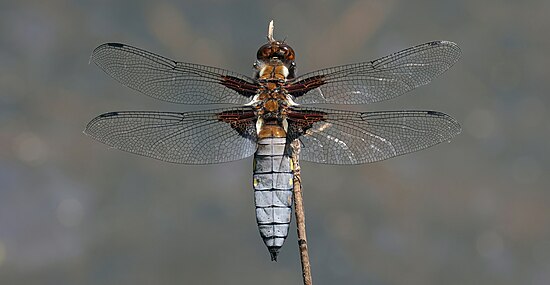Template:POTD protected/2024-04-28: Difference between revisions
Creating protected version of a WP:POTD template by substing from {{POTD/2024-04-28|row}} |
sync |
||
| Line 1: | Line 1: | ||
{| role="presentation" style="margin:0 3px 3px; width:100%; box-sizing:border-box; text-align:center; background-color:transparent; border-collapse:collapse; padding:0.9em" |
{| role="presentation" style="margin:0 3px 3px; width:100%; box-sizing:border-box; text-align:center; background-color:transparent; border-collapse:collapse; padding:0.9em" |
||
| [[File:Broad-bodied |
| [[File:Broad-bodied chaser (Libellula depressa) male dorsal side.jpg|550px|''Libellula depressa'']] |
||
|- |
|- |
||
| style="padding:0 0.9em; text-align:left;" | |
| style="padding:0 0.9em; text-align:left;" | |
||
'''''[[Libellula depressa]]''''', commonly known as the broad-bodied chaser or broad-bodied darter, is a [[dragonfly]] in the family [[Libellulidae]]. One of the most common dragonflies in Europe and central Asia, its range extends to England, central Asia and the Middle East, with a few limited populations in Scotland. It is not found in Ireland or North Africa, however. This insect is around |
'''''[[Libellula depressa]]''''', commonly known as the broad-bodied chaser or broad-bodied darter, is a [[dragonfly]] in the family [[Libellulidae]]. One of the most common dragonflies in Europe and central Asia, its range extends to England, central Asia and the Middle East, with a few limited populations in Scotland. It is not found in Ireland or North Africa, however. This insect is around 39 to 48 millimetres (1.5 to 1.9 inches) in length, with both the male and the female having a broad, flattened abdomen which is brown with yellow patches down the sides. In the male, the abdomen develops a blue [[pruinescence]] that covers the brown colour. Both fore and hind wings have a dark patch at the base. This male ''L. depressa'' dragonfly was photographed at [[Wolvercote]] Lakes in Oxfordshire, England. |
||
<p style="text-align:center;"><small>Photograph credit: [[User:Charlesjsharp|Charles J. Sharp]]</small></p> |
<p style="text-align:center;"><small>Photograph credit: [[User:Charlesjsharp|Charles J. Sharp]]</small></p> |
||
<div class="potd-recent" style="text-align:right;"> |
<div class="potd-recent" style="text-align:right;"> |
||
Latest revision as of 23:43, 26 April 2024

|
|
Libellula depressa, commonly known as the broad-bodied chaser or broad-bodied darter, is a dragonfly in the family Libellulidae. One of the most common dragonflies in Europe and central Asia, its range extends to England, central Asia and the Middle East, with a few limited populations in Scotland. It is not found in Ireland or North Africa, however. This insect is around 39 to 48 millimetres (1.5 to 1.9 inches) in length, with both the male and the female having a broad, flattened abdomen which is brown with yellow patches down the sides. In the male, the abdomen develops a blue pruinescence that covers the brown colour. Both fore and hind wings have a dark patch at the base. This male L. depressa dragonfly was photographed at Wolvercote Lakes in Oxfordshire, England. Photograph credit: Charles J. Sharp
Recently featured:
|
